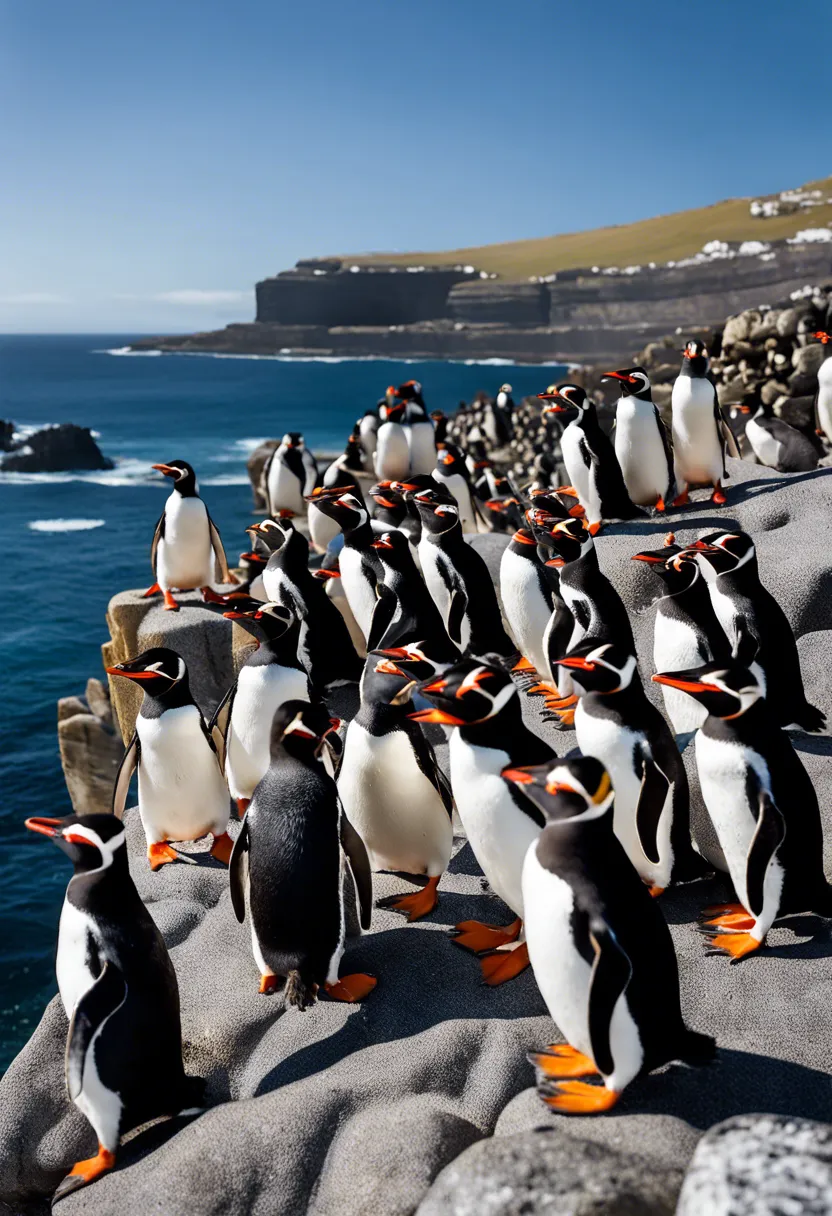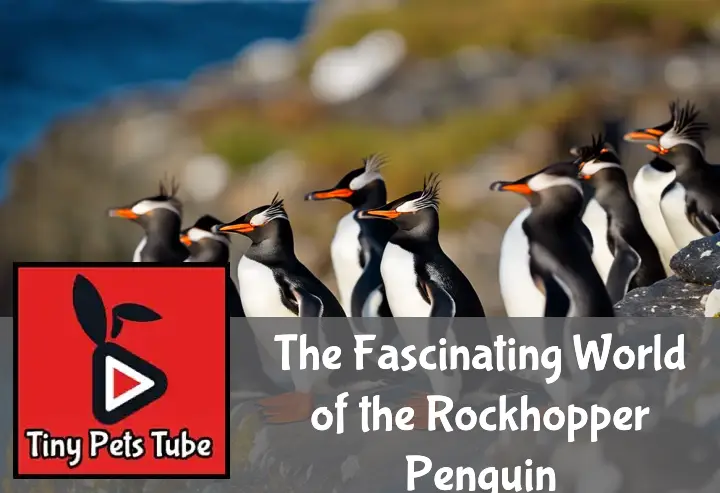Ever stumbled across the term Rockhopper Penguin and wondered what in the world it could be? Well, they’re not a rock band from the 80s, nor are they a new extreme sport. They’re actually one of nature’s most charismatic little creatures, full of surprises and quirks!
In this blog post, we’ll dive headfirst into the fascinating world of these spiky-haired seabirds. Get ready for an adventure that will take us from their unique physical features to their intriguing social behaviors. So buckle up folks! “Keep reading about The Fascinating World of the Rockhopper Penguin”.
Key Takeaways
- Rockhopper Penguins are small, distinctive species found in subantarctic regions.
- They are known for their red eyes, pink webbed feet, and yellow crests.
- Unlike other penguins, they prefer to hop over rocks rather than slide on their bellies.
- Their diet mainly consists of krill and small fish.
- Climate change and overfishing pose significant threats to their population.
- Conservation efforts are underway to protect these unique creatures from extinction.

What are Rockhopper Penguins?
Well, if you’re a fan of the quirky and unusual, then you’re in for a treat! Rockhopper Penguins are like the punk rockers of the penguin world. With their distinctive red eyes, pink webbed feet, and wild yellow crests, they’re not your average flightless bird. These little fellas are full of personality and have some pretty unique characteristics that set them apart from their tuxedo-wearing cousins.
Defining the Rockhopper Penguin
So what makes a Rockhopper Penguin stand out in a crowd? Well, first off, they’ve got this funky hairstyle – it’s like they’ve been caught in a wind tunnel! Their feathers stick up in all directions creating these crazy yellow crests on either side of their head. And let’s not forget those intense red eyes that seem to pierce right through ya!
Then there’s their habitat. These guys prefer rocky shorelines (hence the name ‘rockhoppers’) over the icy landscapes most penguins call home. They can be found hopping around (quite literally) on the rugged coasts of islands scattered throughout the Southern Ocean.
And boy oh boy, do they have personality! Rockhopper Penguins are known for their feisty nature and aren’t afraid to throw down if another penguin gets too close to their turf or mate.
The Three Types of Rockhopper Penguins
Now here’s where things get interesting. There are actually three different types of Rockhopper Penguins: Eastern, Northern, and Southern.
The Eastern Rockhoppers live around sub-Antarctic islands and parts of Chile and Argentina. They’re slightly larger than their counterparts with brighter plumage.
Northern Rockhoppers hang out around Tristan da Cunha and Gough Island in the South Atlantic Ocean. They’re distinguished by longer crest feathers and a different call.
Lastly, we’ve got the Southern Rockhoppers who are found on the Falkland Islands and other southernmost islands. They’re the smallest of the bunch with darker plumage.
Each type has its own unique quirks and characteristics, from their physical traits to their breeding habits. But one thing’s for sure – all Rockhopper Penguins are fascinating creatures worth getting to know!
Where do Rockhopper Penguins Live?
Well, let’s dive right into the world of Rockhopper Penguin and their homes. They’re not your typical next-door neighbors, but they sure know how to pick a scenic spot!
Geographic Distribution of Rockhopper Penguins
These little fellas are primarily found in the Southern Hemisphere. You’ll spot them chillin’ (quite literally) on sub-Antarctic islands and even as far south as the Antarctic regions.
The Falkland Islands? Yep, they’re there too! It’s like a penguin paradise, with thousands of these quirky birds waddling around. These islands serve as major penguin breeding grounds, making them an essential part of the rockhopper locations.
Habitat Preferences of Rockhopper Penguins
Now, if you’re thinking these penguins prefer ice castles like their Emperor cousins, think again! The Rockhopper Penguin habitat is all about rocky shores and coastal ecosystems.
They’ve got a knack for picking out prime real estate on steep cliffs overlooking the sea – talk about living life on the edge! These nesting sites provide protection from predators and easy access to their marine buffet.
And speaking of food, these habitats are bursting with marine biodiversity. It’s like having a 24/7 seafood restaurant right at their doorstep! This rich environment plays a crucial role in supporting their lifestyle and breeding habits. So next time you’re dreaming of beachfront property, remember – the rockhoppers got there first!

What Makes the Rockhopper Penguin Unique?

Diving into the world of penguins, one species stands out from the crowd – the Rockhopper Penguin. This little fella has a personality as distinctive as its appearance. Let’s explore what makes this bird so special.
Physical Characteristics and Adaptations
The Rockhopper Penguin’s uniqueness is evident in its physical traits. Sporting a punk-rock hairdo of yellow and black spiky feathers, it’s not your typical tuxedo-wearing penguin. This unique plumage coloration isn’t just for show; it helps them blend into their rocky surroundings.
But wait, there’s more! These guys are built to navigate tricky terrains. Their strong legs and sharp claws give them an edge in their harsh environment, making them expert climbers on steep cliffs. It’s these distinctive physical traits that make their survival strategies so effective.
Behavioral Traits and Social Structure
Now let’s talk about their social behavior patterns. Rockhopper Penguins have a complex social structure, with each bird playing a specific role within the colony. They’re quite chatty too, using a variety of vocalizations to communicate.
When it comes to love, these birds know how to impress. Their mating rituals involve intricate dances and loud calls to attract a mate – talk about putting on a show! Once paired up, they stick together for life, showcasing an admirable parenting style where both parents share duties equally.
Interaction within the Rockhopper community is also fascinating. They’re known for their feisty nature and aren’t afraid to throw down if another penguin steps on their turf. Despite this fiery temperament, they live harmoniously in large colonies – proof that even in the animal kingdom, community matters!
How do Rockhopper Penguins Survive in their Environment?
Living in the harsh Antarctic environment, Rockhopper Penguins have developed some fascinating survival strategies and adaptations. From their unique diet to predator evasion techniques, let’s dive into how these birds manage to thrive.
Diet and Hunting Techniques
When it comes to food, Rockhopper Penguins are not picky eaters. Their diet mainly consists of krill, small fish, and squid. But how do they catch them? Well, they’re expert divers with a knack for identifying prey underwater.
These penguins can dive up to 100 meters deep! They use this skill to chase down their dinner. What’s more interesting is their cooperative hunting strategy. When a group of rockhoppers spots a school of fish, they work together like a well-oiled machine.
They surround the school and take turns diving into the center to grab a bite. It’s like an underwater ballet with a tasty reward at the end!
Predators and Survival Strategies
Life isn’t all fun and games for our Rockhopper Penguin friends though. They’ve got predators lurking around every corner. On land, they face threats from birds like skuas and petrels while in water; seals are their main worry.
But don’t fret! These penguins have some pretty clever evasion tactics up their flippers. For starters, they choose nesting sites that are hard for predators to reach – think steep cliffs or rocky outcrops.
Their black-and-white plumage also acts as camouflage against both sky and sea – handy when you’re trying to avoid becoming someone else’s dinner! And let’s not forget about group vigilance: when one penguin spots danger, it alerts the whole colony. Safety in numbers is definitely the motto here!
What is the Breeding Cycle of a Rockhopper Penguin?
The breeding cycle of the rockhopper penguin is an intricate dance of nature, filled with unique rituals and practices that ensure the survival and growth of their offspring.
Mating Rituals and Nesting Habits
When it comes to mating rituals, these little fellas are quite the romantics. The breeding season rituals kick off with males arriving first at the rockhopper nesting sites, ready to woo their potential mates.
The mate selection process is no less fascinating. Females, being picky as they should be, choose their partners based on their nest-building skills. Yeah, you heard it right! A well-constructed nest using pebbles and grass is a surefire way to win a lady’s heart in the world of rockhoppers.
Once paired up, both parents share responsibilities in incubating their eggs. It’s all about teamwork here!
Parental Care and Chick Development
Now let’s talk about baby rockhoppers or chicks as we like to call them. The parental care provided by these penguins is nothing short of amazing. From hatching to fledging, every stage is carefully monitored by both parents.
During the early days post-hatching, one parent stays back at the nest while the other goes fishing for food. This ensures that there’s always someone guarding against predators and maintaining warmth for the chick.
As they grow older, chicks form crèches (think penguin daycare), which allows parents more time to gather food. Despite this communal setup, parents can recognize their own chick among hundreds – talk about strong parent-chick bonding!
Surviving in harsh conditions isn’t easy though. With threats like starvation and predators lurking around, only half of these adorable chicks make it to adulthood. But hey! That’s life in the wild for you.
What Threats do Rockhopper Penguins Face?
Life’s no picnic for the rockhopper penguin, folks. These feisty little fellas are up against a whole host of threats, both natural and man-made. And it’s not just about survival – these hazards are seriously messing with their mojo.
Natural Threats to Survival
First off, let’s talk about the big bad world of nature. For the rockhopper penguins, there’s a long list of natural predators that’d love to make them lunch. We’re talking seals, sea lions, and even some birds who’ve got a taste for penguin.
Then there’s the issue of climate change. It’s causing havoc in Antarctic regions, leading to habitat loss and food scarcity for our rockhopping buddies. The warmer temperatures mess with their breeding too – it’s like trying to build a sandcastle in a heatwave!
Human-Induced Threats and Conservation Efforts
But it ain’t just Mother Nature giving the rockhoppers grief. Us humans are adding fuel to the fire with pollution and overfishing. Imagine having your dinner stolen right from under your beak! Not cool, right?
Thankfully, we’re not all bad news bears. There are conservation strategies in place to protect these endangered little guys. Protective legislation is helping keep their habitats safe from harm, and efforts are being made globally to combat warming effects on Antarctic wildlife.
And hey, we’ve even got some success stories! There are initiatives out there making real strides in penguin conservation. So while things might look bleak for our rockhopping friends, there’s still hope yet!

To Wrap Up
Just like a rock star, the Rockhopper Penguin has a unique style and an adventurous spirit. From their punk-rock hairdo to their cliff-diving stunts, they truly are the daredevils of the penguin world.
So next time you’re feeling a little adventurous, remember these funky little fellas and let their spirit inspire you. Dive headfirst into life – just like a Rockhopper Penguin!


